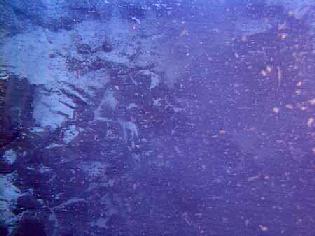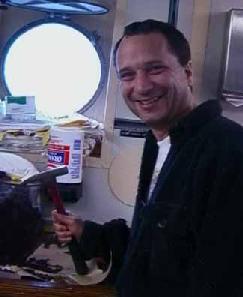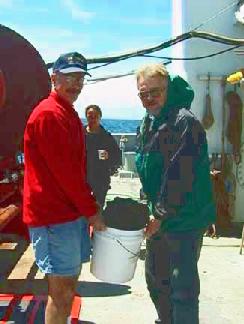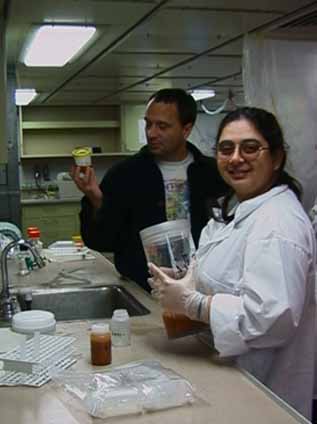WHAT'S NEW:
BACKGROUND:
Mission
Project Description
Cruise Plans:
Participants
Technology (ROV, ships, etc.)
Future Plans
Results:
1998 NeMO Cruise
Axial 1998 "Eruption"
Logbook
July 1, 1999
July 1, 1999
Contents:
- News from Thompson
- Participant Perspective
- Logbook from Teacher at Sea
- Question/Answer from shore to sea
Thompson Science Report
Science Report - Thursday, July 1
Ships Location: 45 54.2/129 55.2
We set a new record for ROPOS bottom time during dive 491 (38 hours)!
Highlights of dive 491 included lots of samples with the slurp
sampler, recovering instruments
into the elevator, recovering bacterial
traps deployed last summer, biological
samples at a number of vent sites, and scanning sonar mapping. One
interesting development during the dive was  the realization that a vent site that we visited on dive 488 and had thought
was new (located near the northern end of the 1998 lava flow near
Milky vent), was actually Magnesia vent (photo right), which we had
sampled last year. The reason we had thought it was new was partly because
one navigation transponder was not working properly on dive 488 and our
positions were offset, and also because the vent now looks very different
from how it appeared last year. Last summer, Magnesia vent had milky-looking
fluid venting with very fine white particles entrained in the fluid. This
year, large white floc particles are coming out of the vent (like at other
"snowblower" vents), but so much floc is coming out and settling to the
bottom that the surrounding area looks like a snowy
winter scene. A big change from last year.
the realization that a vent site that we visited on dive 488 and had thought
was new (located near the northern end of the 1998 lava flow near
Milky vent), was actually Magnesia vent (photo right), which we had
sampled last year. The reason we had thought it was new was partly because
one navigation transponder was not working properly on dive 488 and our
positions were offset, and also because the vent now looks very different
from how it appeared last year. Last summer, Magnesia vent had milky-looking
fluid venting with very fine white particles entrained in the fluid. This
year, large white floc particles are coming out of the vent (like at other
"snowblower" vents), but so much floc is coming out and settling to the
bottom that the surrounding area looks like a snowy
winter scene. A big change from last year.
ROPOS came back on deck this morning and we had hoped to recover the elevator mooring and be back in the water this afternoon, but the wind and seas have been building since yesterday and have caused the elevator recovery and the dive to be postponed. More rock cores from the south rift zone will be collected, and the samples and data collected during dive 491 will be processed in the meantime.
Listing of all Science News postings
Life at Sea: Participant Perspective
Kim Juniper
University of Quebec
 Sometimes scientists
get into a particular field of research through reading and natural curiosity.
More often than not, chance comes into play. Sixteen years ago this summer
I was invited at the last minute to join an oceanographic cruise to the
Juan
de Fuca Ridge. It turned out to be the discovery cruise that found
the first hydrothermal vents in the northeast Pacific Ocean, here
on Axial Volcano. I remember exactly where I was standing on the ship
when the divers in the Pisces IV submersible called up from below to announce
that they had found hot water vents. After the exhilaration of the cruise,
I went to see Ralph Brinkhurst, my post-doctoral supervisor at the Institute
of Ocean Sciences in Sidney, British Columbia. I had worked myself
up to informing him that I wished to terminate the project that he had
assigned me so that I could throw myself into hydrothermal vent research.
Rather than reining me in to carry on with the fjord project that I had
begun six months before, Ralph told me to go for it.
Sometimes scientists
get into a particular field of research through reading and natural curiosity.
More often than not, chance comes into play. Sixteen years ago this summer
I was invited at the last minute to join an oceanographic cruise to the
Juan
de Fuca Ridge. It turned out to be the discovery cruise that found
the first hydrothermal vents in the northeast Pacific Ocean, here
on Axial Volcano. I remember exactly where I was standing on the ship
when the divers in the Pisces IV submersible called up from below to announce
that they had found hot water vents. After the exhilaration of the cruise,
I went to see Ralph Brinkhurst, my post-doctoral supervisor at the Institute
of Ocean Sciences in Sidney, British Columbia. I had worked myself
up to informing him that I wished to terminate the project that he had
assigned me so that I could throw myself into hydrothermal vent research.
Rather than reining me in to carry on with the fjord project that I had
begun six months before, Ralph told me to go for it.
Lately work in my lab has been focusing on the role of free-living microbes as food sources for vent animals. Much is said about how vent ecosystems are unique on the planet because microbes rather than plants provide the basic food energy. Yet we still know very little about how these ecosystems are organized; particularly the "who eats who" part. During the NeMO cruise my students and I are studying vent webs on Axial Volcano. Catherine Charpentier, a student from France, is using a couple of chemical techniques to measure the biomass of microbes in all the samples of floating particles and biofilms that the ROPOS collects. That will provide us with some real data on how much food is actual available. Christian Levesque, a PhD student, is looking at stable isotopes of carbon and nitrogen, and fatty acid biomarkers in animal tissues and comparing them to different food sources. Making these comparisons in vent communities at different stages of development will enable him to understand how vent food webs change as the ecosystem becomes more complex. Marlene Le Bel, a biology undergraduate, is using recorded video images to map the distribution of different types of vent communities within vent fields and on mineral chimneys. Comparing maps from one year to the next will allow us to understand how dynamic these communities really are and how they change in relation to environmental conditions. Finally, ROPOS video cameras are also being used to record how different worm species gather their food, and even defend their feeding territories. Yes, that's right - worms beating up on worms at 1500 metres below the surface of the ocean. There's a lesson in there for all of us. Even when there is abundance, some creatures just can't get enough.
Listing of all Perspectives postings
Teacher At Sea Logbook
Teacher Log #11 7/1/99
Happy Canada Day!!
What a marathon! After 38 hours of excellent work at the seafloor, ROPOS was finally directed back in its cage and was hoisted back on deck. Once it was secured, scientists scurried about recovering the samples that were collected. Samples were distributed appropriately and everyone went about the business of cataloging and fixing organisms, filtering water samples and running the various tests. After a successful dive there is always a good feeling among the members of the science and ROPOS staff, and today was one of those days.
 Mike Perfit and Bob Embley carrying a basalt rock sample collected on ROPOS dive 491. |
 One of the scientists
who collected samples from todays dive is Naaznin Pastakia (photo right)
who is a Masters student from the University
of Toronto. She used the suction
sampler to collect samples of Iron oxyhydroxide produced by microbes
and found on the lava flow. She is interested in specific vents where
this substance is produced. It is her hope to relate this to the iron
and silica rich boundaries seen around pillows in ancient lava flows on
land and prove that they have the same microbial origin.
One of the scientists
who collected samples from todays dive is Naaznin Pastakia (photo right)
who is a Masters student from the University
of Toronto. She used the suction
sampler to collect samples of Iron oxyhydroxide produced by microbes
and found on the lava flow. She is interested in specific vents where
this substance is produced. It is her hope to relate this to the iron
and silica rich boundaries seen around pillows in ancient lava flows on
land and prove that they have the same microbial origin.
After a great day at sea with, the weather is taking a turn for
the worse. The elevator retrieval mission was again postponed due to high
winds and increased seas. It is hoped well be able to get back in the next
day or two.
Bye for now.
Logbook of all Teacher At Sea postings
Questions & Answers
(oar.pmel.vents.webmaster@noaa.gov)